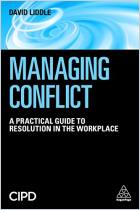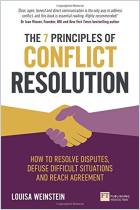Зарегистрируйтесь на getAbstract, чтобы получить доступ к этому краткому изложению.

Зарегистрируйтесь на getAbstract, чтобы получить доступ к этому краткому изложению.
Marlene Chism
From Conflict to Courage
How to Stop Avoiding and Start Leading
Berrett-Koehler, 2022
Что внутри?
A unique guide to help leaders manage conflict and navigate difficult conversations.
Recommendation
Marlene Chism’s decades of experience as a factory worker and more recently as a corporate culture coach give her a unique and valuable perspective on managing conflict and difficult conversations. Like many before her, she advises leaders to face conflict and not avoid it – but she goes on to offer specific advice to help you prepare yourself internally for difficult conversations, so you don’t react to emotional triggers and can listen intently even when you disagree. For leaders especially, this guide to self-regulation, coaching and emotional integrity might make even the hardest conversations more comfortable.
Take-Aways
- Learning to engage in conflict can help you become a better manager and grow personally.
- Conflict itself doesn’t cause problems – mismanaging it does.
- Develop your capacity to confront conflict by learning to tolerate discomfort.
- As a leader, you have the responsibility to clarify and resolve conflicts.
- Managing conflict requires emotional intelligence and integrity.
- Get better at difficult conversations by reflecting, practicing and persevering.
- To break down resistance, use the phrase, “Would you be willing…?”
- Don’t assume you know why people do what they do, and never try to change them.
Summary
Learning to engage in conflict can help you become a better manager and grow personally.
Many leaders – even those at the top – avoid conflict. You shouldn’t go looking for conflict, but you shouldn’t try to avoid or eliminate it, either. Instead, you can turn conflict into a constructive experience by redefining it. And by starting within – making transformations within yourself, first – you can create change in your workplace and often gain others’ agreement, without having to force new ways of doing things.
You might tell yourself that you avoid difficult conversations because you don’t want to hurt the other person’s feelings, but in reality you avoid them because of how they make you feel – the discomfort you expect to feel. You worry the other person might get defensive, their feelings might be hurt, they might resist, or you might lose your temper. Because you don’t want to experience these feelings, you avoid the necessary conversation, and the conflict becomes mismanaged. Thus, the onus remains squarely on you to learn how to engage conflict rather than avoid it.
“Conflict can be seen as a problem that keeps you stuck, or conflict can be seen as a teacher that helps you grow.”
You can build the courage to improve your conflict resolution skills by engaging in disagreements when necessary. And when you do the hard work of confronting conflict, in the process you will learn to manage your emotions, improve your listening skills and become a true coach rather than a mere critic. Your efforts as a leader will improve relationships and outcomes throughout the firm. You’ll build your own emotional integrity and your leadership capabilities.
Conflict itself doesn’t cause problems – mismanaging it does.
Most people think of conflict as a clash, a battle or a personal attack. You can more constructively view it as a misalignment that results from people having differing drives, desires and demands. Conflict itself doesn’t cause the problems that people usually attribute to it; instead, the problems result from mismanagement of the conflict. Mismanagement occurs in the forms of avoidance, appeasement and aggression. Managers appease when, instead of making tough decisions, they give into an employee’s demands or move a person to another part of the organization. Aggression includes using negative body language, sarcasm, and yelling or humiliation.
“It is estimated that employees spend almost three hours per week arguing, and those arguments amount to $359 billion.”
Poorly managed conflict creates severe costs for organizations and individuals. Mismanaged conflict costs US organizations hundreds of billions each year in lost time alone. Add to this the tens of thousands of complaints the Equal Employment Opportunity Commission receives each year, and organizations’ costs to defend them. Beyond the financial drain, mismanaged conflict wears people down. It causes high stress, harms physical and emotional well-being, damages relationships and collaboration, drives attrition and erodes productivity.
Develop your capacity to confront conflict by learning to tolerate discomfort.
A difficult colleague, demanding boss or defensive employee might provoke a strong avoidance reaction in you, but avoiding – although a common practice – only delays and exacerbates problems. And conflict can destroy relationships when people respond by disrespecting, discounting or dismissing another person. Instead, leaders must build “conflict capacity” within themselves and their teams. This means developing the ability to remain engaged during difficult conversations, without getting triggered into avoidance, appeasement or aggression.
“It’s not all about them. It’s all about you and what you don’t want to feel, and that’s how mismanagement begins.”
Conflict capacity depends on a foundation of self-awareness: the ability and determination to recognize your emotions and manage them. It also requires the ability to tolerate the discomfort of recognizing your own dysfunctional behavior patterns. You won’t be able to see and dismantle your own tendencies to avoid, appease or attack if you can’t endure discomfort.
As a leader, you have the responsibility to clarify and resolve conflicts.
Managers often struggle with confronting conflict because they have dysfunctional identities as leaders. Managers who want to be everyone’s friend and value being liked above serving the organization’s mission will tend to mismanage conflict, as will managers who want to be heroes and allow their people to become dependent on them. Those who prize being hands-off will also tend to handle conflict poorly. To manage conflict well, you need to understand that as a leader, you have the power, as well as the responsibility, to resolve conflicts. Aim to become aware of your own triggers and your tendency to avoid conflict. Find a mentor who can help you learn how to spot conflict early on and manage it accordingly. Work on your listening and empathy skills, so you can build trust and belonging with your team.
“Conflict can be your greatest teacher and a catalyst for leadership growth.”
When a conflict arises, think about the situation and context. Ask yourself what’s going on that you hope to stop, what isn’t happening that you would like to happen and how the conflict situation impacts the organization. Know the outcomes you aim for, and note the obstacles in your way, such as the need for resources or skills. Ask yourself how your values and the organization’s can guide you. Knowing your objectives and intentions, and being guided by values, you’ll make better decisions. When you achieve this level of clarity, you’ll find it easier to confront conflict head-on.
Managing conflict requires emotional intelligence and integrity.
Managing conflict and difficult conversations demands heightened emotional awareness and intelligence. Beyond this, you need emotional integrity, which largely boils down to honesty about your own emotions. It means not blaming others for what you feel, acknowledging your negative emotions and sharing that awareness with others. As a leader, especially, it means telling people when you’re too stressed, angry or tired to engage. This helps avoid situations you might later regret, such as losing your cool or yelling in front of your team.
“Think of blame as a shortcut for avoiding responsibility.”
Practice emotional regulation by stepping back and observing yourself, your emotions and your behavior. Take note of how you act when emotions get the better of you. Think about the consequences of your negative reactions and why you want to change. Don’t worry that by suppressing your emotions you will lose your authenticity. Being authentically responsible, self-aware and empathetic beats being authentically angry and childlike. As you practice resisting your emotional triggers, you’ll develop new circuits in your brain – new habits – that will make the practice easier over time.
With greater emotional integrity, you’ll learn to better trust your instincts, and you’ll question the narratives you create about why people behave in certain ways. This will improve the accuracy of the stories you tell yourself about why things happen. You’ll start to focus more on what you can change than on what you can’t.
Get better at difficult conversations by reflecting, practicing and persevering.
Prepare yourself for difficult conversations before you engage. Don’t confront a person when you feel highly stressed or exhausted; instead, schedule a time for the conversation, so you can prepare. Review the story you’ve constructed around the issues and your own emotions. Remember that the ultimate cause for whatever problem you hope to resolve rests with you. Maybe you’ve been unclear or unavailable. Maybe you haven’t built enough personal awareness of your own narratives and biases, and how those might influence your words and actions. Craft a plan for each difficult conversation, including your opening lines.
Initiate the conversation without any preconceived blame aimed at the other party. Picture yourself as the leader who faces down discomfort. Remind yourself of your values, trust yourself, and make a commitment to listen. If you’ve learned to control your triggers and emotions, you’ll be able to listen intently during conflictual conversations and avoid becoming defensive, interrupting to voice your own perspective or getting distracted by thinking about what you’ll say next.
“Not knowing how to start a difficult conversation is one of the most common reasons for avoiding a conversation.”
Share your perspectives from your own experience – don’t claim to represent anyone else. Identify the specific behavior you hope to influence, and stick to what you’ve observed with your own eyes. For example, don’t claim, “You’re always late.” Instead, say, “You were 10 minutes late on Tuesday and five minutes late for a meeting on Thursday.” Talk about the impact of the behavior on others and the business. Ask the person for their perspective, listen intently, ask questions, and stay curious. Don’t dwell on the past: As quickly as possible, move to a discussion about the future – what you hope to see. Use your values and those of the organization as a guide to resolution.
During the conversation, don’t allow the other person to change the subject – a sign of resistance. Get agreement on the topics to be discussed before you begin. Steer conversations back to your objectives. Practice these behaviors in every difficult conversation. Each time, choose one skill you want to work on improving – listening, for example – or a trigger you hope to avoid reacting to during the conversation. Work on it, and gauge your progress. Notice how you feel after each conversation, so you can learn from the experience and improve over time.
To break down resistance, use the phrase, “Would you be willing…?”
You’ll encounter resistance in three forms: other people’s resistance, your own resistance and your resistance to their resistance. Signs of resistance include complaining, negativity, blaming, game playing, making excuses and showing disrespect. Use the SAND acronym – stuck, attached, negative, distracted – to help you identify resistance in yourself and others. To help others overcome being stuck, take a risk, start small, identify barriers, and impose a deadline. Attachment can lead people to talk about the way things used to be done. Help them accept the new conditions, embrace reality and move on.
“Resistance is the nonacceptance of what is and the inability or the unwillingness to make a powerful choice.”
When people show negativity, acknowledge their grievance but move on quickly. Ask them what they want rather than giving them space to complain about what they don’t want. Distraction can take the form of web surfing, eating or any other tactic to avoid making a decision or taking action.
When a person puts up resistance, use the question, “Would you be willing…?” to help them move past it. For example, if the person says a project seems too difficult, ask, “Would you be willing to try if I could do some things to make it easier?” If the person counters with, “Yes, but I don’t have the time,” ask, “Would you be willing if I could reduce the scope by 10 hours a month?” If the person says, “Yes, but Jake will never agree,” say, “Would you be willing to move ahead if I can get Jake’s agreement?” Keep going until you find the person’s core concern.
Don’t assume you know why people do what they do, and never try to change them.
Don’t jump to conclusions about why people do what they do. Ultimately, you can coach people toward the behaviors you like, or you can let them go, but you can’t change them. All you can do is listen, coach, show people they have choices, and hope they arrive at the decision to change themselves. Strive to show employees they have agency and choice. This builds their autonomy, responsibility and accountability, paving the way for less avoidance of difficult conversations, better conflict management and easier overall supervision.
“It’s a lot easier to be a ‘better person’ if your needs are met and you’re well fed and well rested.”
You can also reduce conflict in the workplace by putting in place structures that support well-being. Ensure employees have what they need, including food, coffee, snacks, privacy, flexible work options, breaks, learning opportunities and sufficient leisure time. Make the environment as stable as you can. Think about the behaviors you want to see, lead by example, and provide encouragement, including recognition and incentives.
About the Author
Marlene Chism is a consultant and speaker specializing in resolving workplace drama. She’s the author of No-Drama Leadership and Stop Workplace Drama.
This document is restricted to personal use only.






















Comment on this summary